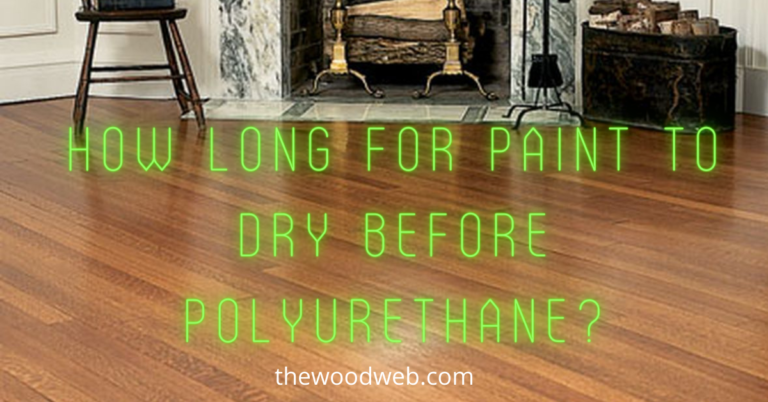How Long Does It Take For Water Based Polyurethane To Dry On Hardwood Floors?
Now that you’ve finished installing your hardwood floor. You’ve probably chosen a water-based polyurethane finish to use, and for that, you’d like to know how long it takes for water-based Polyurethane to dry on hardwood floors.
It takes 24-48 hours for your coating to dry and 30 days to cure completely. But the truth is, it depends on the kind of polyurethane coating you are using, as there are two distinct types of Polyurethane coatings -Oil-based and Water-based.
Another thing to consider also is the weather condition in your environment.
But before plunging into the explanation of what is what, a forehand knowledge about polyurethane itself might help you understand better and even clear out some questions you might have.
All at a Glance
What Is Polyurethane?

Polyurethane is liquid plastic. We need for the coating of our woodwork to be called Polyurethane varnish, and It is made of polyurethane resin dissolved in a liquid solvent, most preferably oil and water. Polyurethane acts as a shield for your wood floors. It protects the wood from the spills and the scratches that come with everyday life.
It is applied by brush or pouring the varnish on the wood. The solvent evaporates with time, and it leaves the poly resin on the wood in the form of varnish.
Choosing between water-based and oil-based Polyurethane depends on your specifications. Like, how fast do you want to move into the building you wish to varnish its floor? What kind of wood are you using for the flooring?
Water-based Polyurethane smells less during application. It also dries and cures faster. Unlike Oil-based, water-based poly dries within 6 hours. After 6 hours, the floor will “look” dry and not be tacky to the touch.
This time, you can’t wear shoes and can’t walk in bare feet. It would smear the varnish with the prints of your sole. But you can wear socks over it until after twenty-four hours.
Oil-based Polyurethane requires more drying and curing time than water-based finishes and is arguably the more durable option. The chemicals used in making oil-based finishes need a well-ventilated area during application, as oxygen is a catalyst. Oil-based polyurethane varnish is more resistant to moisture, heat, and solvents.
Polyurethane Drying Vs. Curing
The two phases to applying Polyurethane to the floor are not to be mistaken for each other. That is Drying and Curing. Polyurethane can be considered dry when the surface is no longer ‘tacky,’ no longer appears wet, and you can apply another coat.
This time, the floor can be walked on, keeping in mind not to wear shoes or walk barefoot, though, as any rough treatment can end up in wrinkles or making unwanted prints on the finished floor.
Polyurethane finish can be considered cured when it has formed the rigid, shiny plastic barrier that will protect the floor once the solvent has dried (whether oil-based or Water-Based), the polyurethane resin begins to react with oxygen in the air chemically. The oxygen reacts with the polyurethane crosslinking the polymer molecules to bind together more firmly.
When you apply multiple coats, each coat’s resins will bind with the former, and then each layer will be crosslinked. This crosslinking means all the layers have blended to form one sizeable dry layer of plastic to protect your floor.
The next question, however, maybe, How many coats should you use? The answer to this question depends on what finish you have decided to use. You wouldn’t want to coat it just once for oil-based products, as the dry wood would immediately soak in the first coating.
So a second coating should be enough, and in some cases, a third coating is advisable. But the maximum amount is just three. Three coatings. As for water-based Polyurethane, four layers are just enough for a perfect finish.
Read Also: How to Fix a Cloudy Polyurethane Finish
Factors affecting polyurethane drying and curing
1.Types of Wood
Some woods produce chemicals that restrain the drying or curing of polyurethane. Woods, like rosewood or aromatic cedar, have natural oils that may cause project delays. This, among others, might pose as a significant drawback to the drying and Curing time.
2. Type Of Polyurethane Finish
Some manufacturers add drying agents, different solvents, and stains for color. Each additional component may impact the dry or cure time of the polyurethane. It may even force you to change the application approach completely.
3. Application Surface
Raw, sanded wood has an open grain and readily absorbs the first polyurethane coat for a short drying time. Subsequent coats take longer to dry as they would take time to crosslink.
4. Temperature and Humidity
The perfect environment for using polyurethane is 70°F (21°C). This will ensure drying times don’t become too long. An increase in temperatures and a decrease in humidity can dramatically lower drying time. Cold, wet days can extend drying time by half a day and interrupt the curing day calculation.
Conclusion
Even though some factors could deter the drying and curing time, it is clear that a water-based poly dries and cure faster than an oil-based poly.







